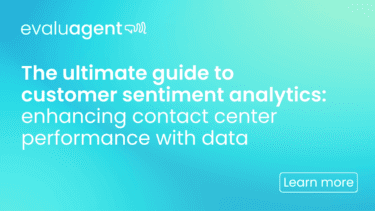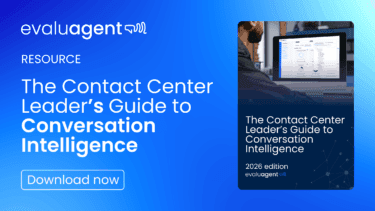The ultimate guide to customer sentiment analytics: enhancing contact center performance with data


What if you could understand the tone, emotion and intent behind a customer interaction, all in an instant?
Well, you can. Under the broader umbrella of conversation intelligence, customer sentiment analytics provide contact centers with unparalleled insight. Having this information to hand, with minimal human effort, gives organizations all the qualitative information they need to improve service quality, agent performance, and customer satisfaction in one hit.
In this article, we explore what customer sentiment analytics entails, its importance, how it works, and the tools and strategies you need to use this transformative technology effectively.
Customer sentiment analytics is the process of drilling down into customer interaction data to better understand their emotions, attitudes, and overall sentiment. By using advanced technologies like artificial intelligence (AI) and natural language processing (NLP), you can decipher subtle emotional cues in calls, chats, emails, and social media interactions.
In the contact center, sentiment analytics go beyond simple keyword tracking. It can identify nuances in tone, word choice, and even the presence of silence and cross-talk, enabling businesses to transform raw customer conversations into valuable insight. The result? Organizations can address customer concerns, optimize processes, and enhance the overall customer experience, just by looking at data they already have.
Customer sentiment has always been a keystone of successful contact centers, but now enhanced with analytics, the process of obtaining and interrogating the information is becoming more seamless.
Now you’re able to identify trends in customer interactions, you can maintain consistent service standards. Sentiment analytics makes it easier to recognize patterns in feedback – such as recurring dissatisfaction with response times – allowing you to proactively address these issues, without investing lots of time and resource into reporting.
Another major development in customer sentiment analytics is just how connected it is to other areas of your contact center. You can provide targeted feedback to agents based on their interactions. For example, you can identify agents with lower customer sentiment scores and take a personalized approach to coaching and training to turn things around.
When pain points are identified promptly, your contact center can feedback solutions to the wider business that improve customer satisfaction. For instance, addressing frequent complaints about product or service quality can lead to more investment into design, research and development.
Ultimately, sentiment analytics uncovers opportunities to optimize operational processes. By understanding what drives negative customer sentiment, you can refine workflows, products, and policies to create a better customer experience.
To start making use of customer sentiment analytics, you’ll first need dedicated contact center intelligence software like evaluagent. The next steps are pretty straightforward.
Your chosen platform will collate all customer interactions across your channel mix – from phone calls and emails to web chats and social media. It’s a good idea to import and/or integrate all your interactions, as the wider your dataset, the more comprehensive understanding of customer sentiment you’ll have. You’ll also be able to make meaningful comparisons between channels too!
Using AI, the collected data is analyzed to determine the sentiment behind each interaction. Feedback is categorized as positive, negative, or neutral, and emotional drivers such as frustration, satisfaction, or confusion can also be identified. In lots of cases, you can also track the impact of agent sentiment too, as well as adjacent metrics, like CSAT or Net Promoter Scores.
Your platform is likely to have an advanced reporting suite to help inform your decision-making. You’ll be able to compare different metrics, channels and topics to really dig deep and find your customers’ pain points.
For example, if sentiment analytics flags frequent complaints about wait times, contact center leaders can prioritize reducing average handle time, improving first-response efficiency. You could work with other departments to also improve communications to customers, reducing the need to get in touch at all.
Imagine a retailer receives frequent calls about delayed shipping. Sentiment analytics reveals a consistent pattern of negative feedback specifically linked to shipping timelines. Armed with this information, the contact center adjusts its communication strategy, proactively updating customers on shipping delays and offering solutions, ultimately improving customer sentiment.
While we’ve already covered the significant advantages you can enjoy with customer sentiment analytics, you may face challenges in implementing it effectively. Common hurdles include:
Analyzing interactions in multiple languages can be daunting, especially for global organizations. Leverage tools with multilingual NLP capabilities to ensure accurate sentiment analysis, and nothing gets lost in translation!
Sentiment analytics tools are incredibly powerful, but their potential is limited if used in isolation. Make sure your chosen platform plays nicely with customer relationship management (CRM) tools or business intelligence platforms to get the best out of your investment.
Customers are more aware than ever of their data and how it’s used. Ensure you have robust data protection measures and policies, a means of anonymizing sensitive information, and locking down certain information to senior managers. As is always good practice, make sure you communicate clearly with customers on how their data is used.
To fully appreciate the value of customer sentiment analytics, it’s essential to measure its impact on both operational metrics and overall customer experience.
Metrics like Customer Satisfaction Score (CSAT) and Net Promoter Score (NPS) will often experience a significant uplift when sentiment analytics is deployed. Because you’ll be addressing negative sentiment promptly, you’ll be laying the foundations for happy customers who keep coming back.
By identifying and resolving customer pain points, sentiment analytics can become a key part of your strategy to reduce churn and increase retention. After all, customers who feel heard and valued are more likely to remain loyal to a brand.
Whether it’s a low sentiment score associated with an agent who needs more support, or recognition for an A-star agent with excellent sentiment score, analytics helps you provide personalized approaches for your whole team.
Doing so not only improves individual performance for those who may be struggling, but also boosts morale and engagement. Now, you can look forward to reduced turnover rates too!
To determine the return on investment (ROI) of sentiment analytics, track key performance indicators (KPIs) such as reduced handling times, increased first-contact resolution rates, and improvements in CSAT and NPS scores. Compare these metrics before and after implementation to gauge the technology’s impact.
As mentioned, if your contact center is looking to harness the power of sentiment analytics, you’ll need a dedicated tool to help you. Look out for these key features:
Ensure the tool can analyze data from all customer touchpoints, including social media, email, live chat, and phone calls. If there are limitations here, you’ll still be missing some of the bigger picture.
Choose a tool that seamlessly integrate with CRM systems, call recording software, and other essential contact center technologies. Check out our integrations library to see just how many other great platforms evaluagentCX works with!
AI and machine learning enable real-time analysis of large volumes of data – but over automation can be a risk too. You need to choose something that scales with you and is capable of handling high volumes of interactions when the need arises. Additionally, ensure that there are features in place to keep you in control of automated workflows.
AI is brilliant, but it works best when combined with human insight.
Choosing a platform to handle QA and customer insights in your contact center can feel a bit daunting – make sure you’ve covered off the crucial aspects before making a decision.
Customer sentiment analytics are a valuable tool for contact centers, enabling you to deliver exceptional service by turning interactions into actionable insights. From improving agent performance and refining processes to boosting customer satisfaction and loyalty, the benefits are clear and measurable.
By investing in advanced sentiment analytics tools and strategies, contact centers can elevate their performance and create meaningful connections with their customers. Don’t wait to embrace the future of customer service – explore the possibilities of sentiment analytics today and transform the way you interact with your audience.

Leading contact centers are using Conversation Intelligence to drive performance, compliance, and customer satisfaction.
If you’re not one of them, this guide will get you up to speed, fast.